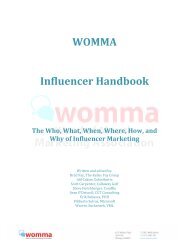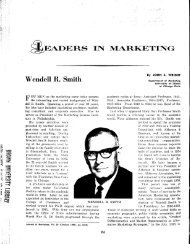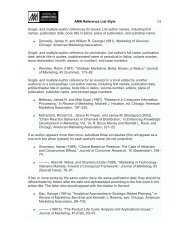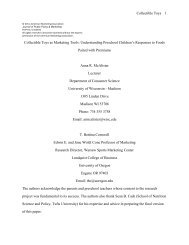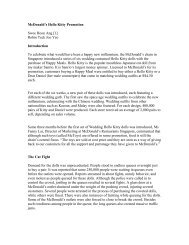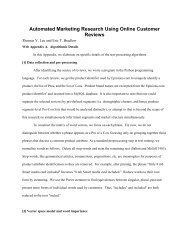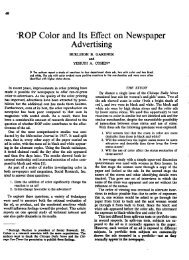FINDING YOUR FOCUS - American Marketing Association
FINDING YOUR FOCUS - American Marketing Association
FINDING YOUR FOCUS - American Marketing Association
You also want an ePaper? Increase the reach of your titles
YUMPU automatically turns print PDFs into web optimized ePapers that Google loves.
22ND ANNUAL<br />
ART2011<br />
Advanced Research Techniques Forum<br />
<strong>FINDING</strong> <strong>YOUR</strong> <strong>FOCUS</strong><br />
June 5–8, 2011<br />
Palm Desert, CA
2<br />
<strong>FINDING</strong> <strong>YOUR</strong> <strong>FOCUS</strong><br />
June 5–8, 2011 • Palm Desert, CA<br />
CONFERENCE COMMITTEE<br />
Wendy Moe, Chair<br />
Associate Professor of <strong>Marketing</strong><br />
University of Maryland<br />
Anocha Aribarg<br />
Assistant Professor of <strong>Marketing</strong><br />
University of Michigan<br />
Chris Chapman<br />
Senior Researcher<br />
Microsoft Advertising R&D<br />
Jeff Dotson<br />
Assistant Professor of <strong>Marketing</strong><br />
Vanderbilt University<br />
Elea McDonnell Feit<br />
Research Director<br />
Wharton Customer Analytics Initiative<br />
David Lyon<br />
Principal<br />
Aurora Market Modeling<br />
<strong>Marketing</strong>Power.com/artforum<br />
Register<br />
by May 5<br />
and save!
Dear Attendee:<br />
22ND ANNUAL<br />
Advanced Research Techniques Forum ART2011<br />
The Advanced Research Techniques Forum focuses on the use of sophisticated<br />
methodologies and quantitative techniques to support strategic and tactical marketing<br />
decisions. The conference, now in its 22nd year, provides a unique opportunity for<br />
academics, practitioners and research clients to exchange ideas and solutions.<br />
The 2011 ART Forum Program Committee has assembled an innovative slate of papers<br />
and posters featuring methods that address both traditional and emerging research<br />
challenges. We have brought back the end-of-day roundtables to give attendees and<br />
speakers a chance to delve deeper into issues raised in the presentations. You may also<br />
notice that we have scheduled additional networking receptions this year. I hope you take<br />
advantage of these receptions to spend time with old friends and to meet new attendees<br />
working on interesting projects.<br />
Over two and a half days of programming, attendees are encouraged to share in a<br />
lively and open discussion of the various methods. Additional learning opportunities are<br />
provided through optional tutorials on a variety of topics. This year, the committee has<br />
worked with a number of new instructors to provide several new tutorial offerings:<br />
 Advanced Computer Simulations for Improved <strong>Marketing</strong> Decisions<br />
 Advanced Theory and Application of Hierarchical Bayes Choice Models<br />
 Analyzing Network Data<br />
 Introduction to Bayesian Statistics and <strong>Marketing</strong><br />
 Introduction to Discrete Choice Modeling<br />
 Introduction to R for <strong>Marketing</strong> Research<br />
 Modeling Market Dynamics<br />
 Structural Modeling of Forward-Looking Consumer Behavior<br />
 Introduction to Text Mining and Sentiment Analysis<br />
 Introduction to Bayesian Networks:<br />
Their Applications in the Field of <strong>Marketing</strong> Science<br />
We hope you’ll join us for an exciting and informative 2011 ART Forum!<br />
Wendy Moe<br />
Committee Chair<br />
Associate Professor of <strong>Marketing</strong><br />
University of Maryland<br />
FROM THE CHAIR<br />
<strong>Marketing</strong>Power.com/artforum<br />
3
4<br />
<strong>FINDING</strong> <strong>YOUR</strong> <strong>FOCUS</strong><br />
June 5–8, 2011 • Palm Desert, CA<br />
CONFERENCE PROGRAM<br />
Sunday, June 5<br />
7:45–8:15 am Breakfast<br />
8:15 am–12:15 pm Preconference Tutorials<br />
<strong>Marketing</strong>Power.com/artforum<br />
(see website for complete descriptions)<br />
A. Introduction to Bayesian Statistics and <strong>Marketing</strong><br />
Greg M. Allenby, The Ohio State University<br />
B. Introduction to Discrete Choice Modeling<br />
Brian Orme, Sawtooth Software<br />
Jon Pinnell, MarketVision Research<br />
C. Introduction to R for <strong>Marketing</strong> Research<br />
Eric Zivot, University of Washington<br />
Chris Chapman, Microsoft<br />
D. Introduction to Text Mining and Sentiment Analysis<br />
Matt Taddy, University of Chicago<br />
12:15–1:00 pm Lunch on Your Own<br />
1:00–5:00 pm Preconference Tutorials<br />
(see website for complete descriptions)<br />
E. Advanced Computer Simulations for Improved <strong>Marketing</strong> Decisions<br />
David G. Bakken, KJT Group<br />
F. Analyzing Network Data<br />
Wolfgang Jank, University of Maryland<br />
G. Structural Modeling of Forward-Looking Consumer Behavior<br />
Andrew Ching, University of Toronto<br />
5:00–5:30 pm New Attendee Orientation<br />
5:30–7:00 pm Welcome Reception<br />
Register<br />
by May 5<br />
and save!
Monday, June 6<br />
22ND ANNUAL<br />
Advanced Research Techniques Forum ART2011<br />
7:45–8:15 am Breakfast<br />
8:15 am–12:00 pm Monday Morning Sessions<br />
SESSION 1:<br />
EMERGING METHODS<br />
Evolving Viral <strong>Marketing</strong> Strategies<br />
William Rand, University of Maryland<br />
Forrest Stonedahl, Northwestern University<br />
Uri WIlensky, Northwestern University<br />
As the growth of social media accelerates, viral marketing as a mechanism to<br />
spread an idea or product through online social venues has become increasingly<br />
important. However, in a complex social network, which consumers should be<br />
targeted to maximize the reach and increase the speed of diffusion within these<br />
systems? We explore a way to select consumers on the basis of local network<br />
properties, and then examine how these network properties affect the ability of<br />
consumers to influence their social networks. In the end, to provide an answer<br />
to the question of which consumers to target, we construct a tool that uses<br />
a combination of social network metrics, agent-based modeling and genetic<br />
algorithms, to discover a robust solution that we demonstrate on several social<br />
networks, including Twitter and a college alumni social networking site.<br />
Exponential Random Graph Models of<br />
Linked Records in a Consumer Panel<br />
Mark Kinnucan, The Nielsen Company<br />
Christina Gutierrez, The Nielsen Company<br />
Recent concerns about online panel quality have prompted efforts to ensure that<br />
panels are free of duplicate registrations; these efforts have become a standard<br />
practice in the market research industry. In the process of identifying duplicates,<br />
the duplicate records are linked. By studying the networks formed by these links,<br />
we can increase our understanding of the threat posed by duplicates in a panel.<br />
Recent advances in estimation, inference and software availability of exponential<br />
random graph models (ERGMs) have greatly increased their utility for analyzing<br />
social and other networks. This presentation describes the use of ERGMs (also<br />
called p* models) to explore the panelist attributes and network microstructures<br />
that characterize duplication within an active online panel.<br />
<strong>Marketing</strong>Power.com/artforum<br />
5
6<br />
<strong>FINDING</strong> <strong>YOUR</strong> <strong>FOCUS</strong><br />
June 5–8, 2011 • Palm Desert, CA<br />
SESSION 2:<br />
EXTENDING CHOICE MODELING TO NEW DOMAINS<br />
Forecasting Multi-Channel Media Consumption<br />
During the World Cup<br />
Elea McDonnell Feit, Wharton Customer Analytics Initiative<br />
Pengyuan Wang, The Wharton School, University of Pennsylvania<br />
Eric T. Bradlow, Wharton Customer Analytics Initiative<br />
Peter S. Fader, Wharton Customer Analytics Initiative<br />
We investigate customer behavior on multiple media platforms around the world’s<br />
largest sporting event, the 2010 FIFA World Cup, with the aim of understanding<br />
and projecting multi-platform consumption habits of the United States audience<br />
across digital properties including websites, streaming video and mobile. The effect<br />
of the game schedule on each individual’s multi-platform usage is modeled as a<br />
function of latent teams’ media attractiveness parameters, and allows for us to<br />
understand the interplay (if it exists at all) between each team’s FIFA world rankings<br />
(indicating the quality of the team on the field) and a team’s ability to draw viewers<br />
to the event (its media attractiveness). Through a correlation structure, the model<br />
also allows us to explore the relationship between channels. The resulting model<br />
allows us to predict and understand multi-channel reach and frequency around<br />
this event—commonly used metrics critical to planning and pricing advertising in a<br />
multi-platform media environment.<br />
On the Use of Bootstrap and Ensemble Methodology<br />
for Improving DCM Predictions<br />
Cazhaow Qazaz, MarketTools Inc.<br />
Joseph Retzer, MarketTools Inc.<br />
One of the most important considerations in discrete choice modeling is the size<br />
of the survey sample. While the issue can be addressed via appropriate statistical<br />
analysis, reality often dictates that the researcher has little or no control over<br />
the data size. There are situations, for example, where the size of the population<br />
is inherently small. Other contributing factors include cost and time limitations<br />
associated with the data gathering, thus marketers are often faced with an<br />
insufficient amount of data to do the modeling work. In this paper, we demonstrate<br />
that DCM ensembles, created via bootstrap samples, can alleviate the worst<br />
symptoms of the problem and yield improved predictions.<br />
<strong>Marketing</strong>Power.com/artforum
22ND ANNUAL<br />
Advanced Research Techniques Forum ART2011<br />
12:00–1:00 pm Lunch<br />
1:00–4:30 pm Monday Afternoon Sessions<br />
SESSION 3:<br />
MODELING CUSTOMER CHURN<br />
What Are Your Customers Still Doing?<br />
A Bivariate Attrition Model<br />
David A. Schweidel, University of Wisconsin-Madison<br />
Young-Hoon Park, Cornell University<br />
Zainab Jamal, HP Laboratories<br />
While attrition models are commonly used for customer valuation and identifying<br />
those customers who are still “alive,” extant research has considered only a single<br />
type of transactional activity. In a number of contexts, customers may engage in<br />
multiple activities, such as purchasing in multiple product categories and shopping<br />
across different channels. In this research, we employ a bivariate attrition model<br />
to examine the way in which customers cease engaging in two non-sequential<br />
activities—whether all at once or through a tiered attrition process. Leveraging the<br />
relationship between the two activities, we demonstrate how jointly examining them<br />
offers a more complete picture of customers’ dynamic behavior than analyzing the<br />
individual activities in isolation.<br />
Modeling Customer Lifetimes with<br />
Multiple Causes of Churn<br />
Michael Braun, Massachusetts Institute of Technology<br />
David A. Schweidel, University of Wisconsin-Madison<br />
Register<br />
by May 5<br />
and save!<br />
Customer retention and customer churn are key metrics of interest to marketers,<br />
but little emphasis has been placed on linking the different reasons for which<br />
customers churn to their value to a contractual service provider. Some of these<br />
reasons for churn can be influenced by the firm (e.g., service problems or pricevalue<br />
tradeoffs), but others are uncontrollable (e.g., customer relocation and death).<br />
We examine how the relative likelihood to end service due to different reasons<br />
shifts during the course of the customer-firm relationship, and how the effect of a<br />
firm’s efforts to reduce customer churn for controllable reasons are mitigated by<br />
the presence of uncontrollable ones. The result is a measure of the “upper bound”<br />
on the return to retention marketing that a firm can expect to accrue by delaying<br />
churn for different reasons—for customers with different demographic profiles and<br />
different elapsed tenures with the firm.<br />
<strong>Marketing</strong>Power.com/artforum<br />
7
8<br />
<strong>FINDING</strong> <strong>YOUR</strong> <strong>FOCUS</strong><br />
June 5–8, 2011 • Palm Desert, CA<br />
SESSION 4:<br />
REFINEMENTS IN CHOICE MODELING<br />
A Conjoint Model for Allocation Data<br />
Jeff Brazell, The Modellers<br />
Takuya Satomura, Keio University, Japan<br />
Greg M. Allenby, The Ohio State University<br />
In industry, various research needs lead us to ask allocation questions in conjoint<br />
studies. For example, in pharmaceutical studies, it is a common industry practice<br />
to ask physicians to allocate treatments across patients. Similarly, allocation<br />
questions may be appropriate in situations where respondents purchase products<br />
across multiple occasions, or as a representative for multiple people (e.g., a parent<br />
for her family), when studying a category with variety seeking, or in other contexts<br />
where decision-makers typically order products or services in quantity (e.g.,<br />
shipper selection). Typical approaches to analyzing these data rely on regression<br />
analysis or assume that respondents are providing independent responses to<br />
different choice tasks. We propose a new model based on a constrained utility<br />
maximization. We show in-sample and predictive improvements over the use of<br />
existing models, particularly in identifying choice options with low demand.<br />
Controlling for Complex Nonverbal Stimuli in a Choice Model<br />
Mark A. Beltramo, General Motors<br />
Jeff P. Dotson, Vanderbilt University<br />
Elea McDonnell Feit, Wharton Customer Analytics Initiative<br />
Randall C. Smith, General Motors (Retired) and Oakland University<br />
It is well established that in many product categories, industrial design has an<br />
important influence on consumer choice. Consequently, product designers often want<br />
to understand the effect of design on product choice, but it hasn’t been clear how to<br />
incorporate such complex, multi-dimensional attributes into consumer choice models.<br />
Existing approaches either ignore important information about visual design and its<br />
effect on vehicle choice—particularly the fact that individuals differ in what they find<br />
appealing—or subject respondents to long and difficult tasks where they rate many<br />
alternative new designs. Because it is so difficult to measure preferences for visual<br />
designs, choice modelers often treat a design as equally appealing to all consumers.<br />
But when the effect of design at the individual level is ignored, the observed individual<br />
behavior is likely to violate the Independence of Irrelevant Alternatives property, a<br />
core assumption underlying the vast majority of choice models used in business<br />
practice, including hierarchical choice models. We propose a new approach that<br />
controls for the fact that customers who prefer one vehicle’s shape are likely to prefer<br />
similar-shaped vehicles. Using choice-based conjoint data for crossover vehicles, we<br />
demonstrate that the proposed model makes better predictions about which products<br />
will gain or lose share when a new vehicle enters the market. We will discuss how<br />
such methods can be applied to other complex attributes, such as speed of a<br />
computer, sound quality of a stereo or taste of a snack food.<br />
<strong>Marketing</strong>Power.com/artforum<br />
Register<br />
by May 5<br />
and save!
22ND ANNUAL<br />
Advanced Research Techniques Forum ART2011<br />
4:30–5:15 pm Speaker Roundtables<br />
5:15–6:45 pm Networking Reception and<br />
Poster Sessions<br />
Tuesday, June 7<br />
7:45–8:15 am Breakfast<br />
8:15 am–12 pm Monday Morning Sessions<br />
SESSION 5:<br />
DYNAMIC MODELS AND ONLINE DATA<br />
From Online Search to Offline Demand:<br />
A Dynamic Model of the Hierarchical Effects of Advertising<br />
Stefan Conrady, Conrady Applied Science, LLC<br />
Qing Liu, University of Wisconsin-Madison<br />
Jeff P. Dotson, Vanderbilt University<br />
Sandeep Chandukala, Indiana University<br />
Active consumer participation in online product and information markets has<br />
created a rich source of secondary data. Although the conditions that motivate<br />
individuals to buy, sell, search and post on the Internet are diverse, the information<br />
generated as a byproduct of these activities has the potential to help marketers<br />
develop a better understanding of consumer behavior. In this paper, we collect and<br />
utilize online product consideration data for luxury automobiles in order to build a<br />
dynamic model of sales and advertising. Our model allows us to better forecast<br />
sales while simultaneously providing insights into the role of advertising in the sales<br />
generation process.<br />
Quantitative Trendspotting – Identify Common Trends<br />
Hidden Behind a Large Number of Time Series<br />
Rex Yuxing Du, University of Houston<br />
Wagner A. Kamakura, Duke University<br />
We demonstrate how trendspotting can be performed quantitatively by<br />
systematically uncovering key common trends hidden behind a large number of<br />
observed signals over time. By developing a state-of-the-art Structural Dynamic<br />
Factor-Analytic (SDFA) model and applying it to multitudes of time series, we are<br />
able to distill a large set of noisy individual signals into a few key smooth latent<br />
trends that isolate seasonal movements from non-seasonal shifts in consumer<br />
<strong>Marketing</strong>Power.com/artforum<br />
9
10<br />
<strong>FINDING</strong> <strong>YOUR</strong> <strong>FOCUS</strong><br />
June 5–8, 2011 • Palm Desert, CA<br />
interests and behaviors. We demonstrate this novel approach to trendspotting<br />
with an application in the U.S. automotive industry using online keyword search<br />
data from Google Insights for Search. Our results show that online consumer<br />
interest tracking services such as Google Insights can be mined more effectively<br />
as a powerful source of marketing intelligence in spotting and projecting major<br />
trends in the marketplace. Of course, our proposed method can also be applied to<br />
identifying hidden trends from more traditional sources, such as sales data tracked<br />
by syndicated service providers or customer interaction data from firms’ transaction<br />
databases.<br />
SESSION 6:<br />
PRODUCT LINE OPTIMIZATION<br />
Enhancing <strong>Marketing</strong> with Engineering:<br />
Designing Optimal Product Lines for a Heterogeneous Audience<br />
Jeremy Michalek, Carnegie Mellon University<br />
Peter Ebbes, The Ohio State University and Penn State University<br />
Feray Adiguzel, Vrije Universiteit Amsterdam<br />
Fred Feinberg, University of Michigan<br />
Panos Papalambros, University of Michigan<br />
Successful product line design and development require balancing technical and<br />
market tradeoffs. “Preference elicitation” methods like conjoint help marketers<br />
learn which attributes and levels consumers desire, but not with achieving those<br />
desired attribute levels in designing products, which is critical for products with<br />
heavy engineering content. This is especially critical for product lines, where<br />
additional products launched to capture new segments can lead to serious losses<br />
via cannibalization.<br />
Bias in Main Effects Models for Line Optimization<br />
Kevin D. Karty, VP Analytics, Affinnova, Inc.<br />
This presentation identifies a source of bias in line optimization models that results<br />
from the use of fractional factorial utility structures in the core model estimation;<br />
compares and contrasts with full factorial models. Isolates an artificial tendency<br />
of line optimizations derived from main effects models to include variations along<br />
multiple dimensions even when the true underlying preference structure does not<br />
support a need for variation along multiple dimensions.<br />
<strong>Marketing</strong>Power.com/artforum
22ND ANNUAL<br />
Advanced Research Techniques Forum ART2011<br />
12:00–1:00 pm Lunch<br />
1:00–4:30 pm Tuesday Afternoon Sessions<br />
SESSION 7:<br />
MODELING THE NEW SOCIAL ENVIRONMENT<br />
‘Social Dollars’: The Economic Impact of Consumer<br />
Participation in a Firm-Sponsored Brand Community<br />
Puneet Manchanda, University of Michigan<br />
Grant Packard, University of Michigan<br />
Adithya Pattabhiramaiah, University of Michigan<br />
Many firms have jumped on the social media/Web 2.0 bandwagon by developing<br />
brand-specific consumer social networks or communities online in the belief<br />
that consumers who join the brand’s online social network/community are likely<br />
to become more engaged with the brand. The end objective of such firms is to<br />
leverage this engagement to generate what we call the “social dollars.” These<br />
social dollars represent the incremental revenue from the engaged consumer (as<br />
a result of joining the brand community). Using a unique dataset from a firm that<br />
established a brand community in 2007, we show (via a difference-in-differences)<br />
estimator that social dollars are equivalent to a 19% increase in revenue for the<br />
firm. We show that this finding is robust to a variety of alternative explanations and<br />
provide some insights into the behaviors that suggest high levels of engagement.<br />
Empirically Investigating the Relationship Between<br />
What Brands Do and What Consumers Say (Social Media),<br />
Sense (Mindset) and Do (Purchase)<br />
Manish Tripathi, Emory University<br />
Douglas Bowman, Emory University<br />
Larry Friedman, TNS Global<br />
Melinda Smith de Borrero, TNS Global<br />
Natasha Stevens, Cymfony<br />
Market research practitioners are just beginning to understand how to quantitatively<br />
use social media data. There is very limited work on relating this content to other<br />
data collected (brand tracking surveys) and disseminated (brand-generated<br />
content) by a firm. A contribution of this research is to provide both a visual (brand<br />
positioning maps) and quantitative framework to describe the relationship betweens<br />
the firm’s message and the customer’s verbal and attitudinal disposition.<br />
<strong>Marketing</strong>Power.com/artforum<br />
11
12<br />
<strong>FINDING</strong> <strong>YOUR</strong> <strong>FOCUS</strong><br />
June 5–8, 2011 • Palm Desert, CA<br />
SESSION 8:<br />
THE UPPER LEVEL IN HIERARCHICAL CHOICE MODELS<br />
Covariates in Discrete Choice Models: Are They Worth the Trouble?<br />
Dimitri Liakhovitski, Ninah Consulting Ltd.<br />
Faina Shmulyian, MarketTools, Inc.<br />
Jia Liu, Columbia Business School<br />
This research compared Hierarchical Bayesian estimation of Discrete Choice<br />
utilities with and without covariates. The performance of both estimation methods<br />
was examined under a number of scenarios when the true relationship between<br />
the covariate and the true utilities was known. Several experimental factors were<br />
varied and their impact on the estimation quality of both methods considered. The<br />
relevance of the results to practitioners is discussed and possible “rules of thumb”<br />
for considering covariates are formulated.<br />
Identifying Unmet Demand<br />
Sandeep R. Chandukala, Indiana University<br />
Yancy D. Edwards, St. Leo University<br />
Greg M. Allenby, The Ohio State University<br />
Brand preferences and marketplace demand are a reflection of the importance<br />
of consumer need and the efficacy of product attributes in delivering value. Dog<br />
owners, for example, may look to dog foods to provide specific benefits for their<br />
pets (e.g., shiny coats) that may not be available from current offerings. An analysis<br />
of consumer wants for these consumers would reveal weak demand for product<br />
attributes due to low efficacy, despite the presence of strong latent interest. The<br />
challenge in identifying such unmet demand is in distinguishing it from other<br />
reasons for weak preference, such as general non-interest in the category and<br />
heterogeneous tastes. We propose a model for separating out these effects within<br />
the context of conjoint analysis, and demonstrate its value with data from a national<br />
survey of toothpaste preferences. Implications for product development and<br />
re-formulation are explored.<br />
4:30–5:15 pm Speaker Roundtables<br />
5:15–6:45 pm Networking Reception and<br />
Poster Sessions<br />
<strong>Marketing</strong>Power.com/artforum<br />
Register<br />
by May 5<br />
and save!
22ND ANNUAL<br />
Advanced Research Techniques Forum ART2011<br />
Wednesday, June 8<br />
8:15 am–12:00 pm Wednesday Morning Sessions<br />
SESSION 9:<br />
KEY DRIVERS ANALYSIS<br />
Do We Halo or Form? A Bayesian Mixture Model<br />
for Customer Satisfaction Data<br />
Joachim Büschken, Catholic University of Eichstätt (Germany)<br />
Thomas Otter, University of Frankfurt (Germany)<br />
Greg M. Allenby, The Ohio State University<br />
The analysis of customer satisfaction data to identify the drivers of satisfaction<br />
assumes that respondents provide independent assessments of the components<br />
that make up the overall satisfaction score. But what if, instead of forming an<br />
overall measure from the components, some respondents recalled their overall<br />
satisfaction, and then assigned component scores that were consistent with the<br />
aggregated score? Respondent scores would then exhibit a halo effect, and the<br />
components would be uninformative about the drivers of overall satisfaction. We<br />
present a new model for identifying haloed responses, and find that respondents<br />
who are most likely to halo are those most familiar with the offering. Conversely,<br />
those who do not halo are individuals less likely to have had in-depth experience.<br />
This presents a dilemma in terms of how and when to collect data and how to<br />
interpret results.<br />
Key Drivers Methods in Market Research:<br />
A Comparative Analysis<br />
Michael Egner, Ipsos Open Thinking Exchange<br />
Scott Porter, Ipsos Open Thinking Exchange<br />
Robert Hart, Jr., Ipsos Open Thinking Exchange<br />
Although the analysis of key drivers is one of the most common tasks in market<br />
research, practitioners have not reached a consensus on which techniques are<br />
best—particularly in the presence of multicollinearity, non-linear effects and other<br />
data complexities. Over the years, proponents of various statistical techniques<br />
have claimed that their preferred methods can “fix” or otherwise account for<br />
such problems when running drivers analysis. To evaluate these claims, we<br />
simulated data exhibiting these complexities, and evaluated how well a variety of<br />
techniques—including ridge regression, PLS, Shapley value analysis, Bayesian<br />
networks, decision tree ensembles, neural nets, and support vector machines<br />
(SVMs)—captured the true impact of changing a driver on a key outcome. We<br />
<strong>Marketing</strong>Power.com/artforum<br />
13
14<br />
<strong>FINDING</strong> <strong>YOUR</strong> <strong>FOCUS</strong><br />
June 5–8, 2011 • Palm Desert, CA<br />
show that many methods claiming to address multicollinearity are blind to the<br />
underlying structural relationships that give rise to the high correlations. As a<br />
result, these methods may give even more misleading measures of impact than<br />
OLS. Accordingly, we recommend methods that incorporate a search for structure<br />
among the variables being studied.<br />
Non-Compensatory Customer Satisfaction Modeling<br />
Keith Chrzan, Chief Research Officer, Maritz Research<br />
Michael Kemery, Senior Research Consultant, Maritz Research<br />
Customer satisfaction studies typically use “derived” importance models that<br />
assume a linear, compensatory relationship between performance attribute inputs<br />
and overall satisfaction outputs. However, performance on some attributes might be<br />
so terrible (or excellent) that they, all by themselves, ruin (or perfect) a customer’s<br />
experience. Joffre Swait introduced a clever way to sneak non-compensatory<br />
effects into aggregate MNL conjoint models (Swait 1998, 2001) and to reap<br />
benefits as a result. Adapting Swait’s non-compensatory approach to customer<br />
satisfaction analysis may allow customer satisfaction researchers to gain some of<br />
these benefits as well. Using six empirical studies, we illustrate this method, its<br />
results and its performance relative to standard customer satisfaction modeling.<br />
12:45–4:45 pm Postconference Tutorials<br />
<strong>Marketing</strong>Power.com/artforum<br />
(see website for complete descriptions)<br />
H. Advanced Theory and Application of Hierarchical Bayes Choice Models<br />
Jeff P. Dotson, Vanderbilt University<br />
Elea McDonnell Feit, Wharton Interactive Media Initiative<br />
I. Introduction to R for <strong>Marketing</strong> Research (Repeat)<br />
Eric Zivot, University of Washington<br />
Chris Chapman, Microsoft<br />
J. Modeling Market Dynamics<br />
Prasad Naik, University of California-Davis<br />
K. Introduction to Bayesian Networks:<br />
Their Applications in the Field of <strong>Marketing</strong> Science<br />
Lionel Jouffe, Bayesia SAS<br />
Stefan Conrady, Conrady Applied Science, LLC
22ND ANNUAL<br />
Advanced Research Techniques Forum ART2011<br />
POSTER SESSIONS<br />
Using Memory Persistent Techniques in Classification Algorithms<br />
Christopher Perkins, Roche Diabetes Care<br />
In many market research situations, the product/marketing team aims to classify<br />
observations into one of two groups. Methods for achieving this include logistic<br />
regression, discriminate analysis, neural nets and support vector machines (SVMs).<br />
This poster presents a novel approach to solving a problem related to SVMs: when<br />
training data is supplemented with new information, the methodology does not<br />
require restarting the “learning process” on the entire training data. It is possible to<br />
continue the algorithm leveraging the learnings already achieved on the preliminary<br />
dataset but now including the augmented data.<br />
Model-Based Estimation of CBC Attribute Impact<br />
Chris Chapman, Microsoft Advertising R&D<br />
James Alford, Blink Interactive<br />
This poster presents a new measure of attribute “impact” to supplement traditional<br />
choice model measures of attribute importance. The new method is adapted from<br />
variable importance detection methods used in machine learning and models the<br />
contribution that an attribute makes to predicting choices at a full model level. The<br />
poster outlines the approach, compares it to traditional importance measures, and<br />
offers free code in R to estimate the impact measures for standard CBC studies.<br />
Applying Visualization and Text Mining Techniques<br />
to Consumer-Generated Media<br />
Kurt A. Pflughoeft, Maritz<br />
Felix Flory, evolve24<br />
Capturing information from “unstructured” sources such as consumer-generated<br />
media presents significant challenges in summarizing and displaying the data. The<br />
use of advanced text mining and visualization techniques provides a powerful way<br />
for clients to understand this data. A case study is used to show how this process<br />
works and what type of client deliverables can be constructed.<br />
Register<br />
by May 5<br />
and save!<br />
<strong>Marketing</strong>Power.com/artforum<br />
15
16<br />
<strong>FINDING</strong> <strong>YOUR</strong> <strong>FOCUS</strong><br />
June 5–8, 2011 • Palm Desert, CA<br />
Using Synthetic Data to Understand the Best Approach to<br />
Accounting for Cannibalization in Market Simulations<br />
Jeffrey Dumont, Resource Systems Group, Inc.<br />
Nelson Whipple, Resource Systems Group, Inc.<br />
Independence from irrelevant alternatives (IIA) is a well-known issue in choice<br />
modeling. Improper accounting for IIA results in inaccurate cannibalization rates in<br />
market simulations. By creating a synthetic set of “scanner data,” different modeling<br />
techniques developed in response to IIA can be compared for their efficacy with<br />
respect to retrieving the true cannibalization rate in the market. Aggregate MNL, HB<br />
MNL, Nested Logit, SOV probit, randomized first choice and enhanced randomized<br />
first choice are tested to understand their overall effectiveness in measuring true<br />
cannibalization.<br />
Measuring the Delightfulness Evoked by<br />
Products through Online Reviews<br />
Daniel H. Abbott, Blink Interactive<br />
A new method is described to measure the delight evoked by products through<br />
online reviews. A large corpus of reviews is assembled, and canonical ratings of<br />
training cases are used in human subjects. Several methods are then used to<br />
estimate scores for the rest of the corpus. Face validity is measured, and delight’s<br />
effect on choice-based purchasing decisions is calculated. Areas of future research<br />
are discussed.<br />
Alternative Approaches to Choice-Based Conoint-Analysis:<br />
Is Best-Worst Better and Do We Need HB?<br />
Ralph Wirth, GfK <strong>Marketing</strong> Sciences<br />
In this presentation, different approaches for estimating part-worth utilities from<br />
CBC data are compared: Standard CBC, Best-Worst CBC (both estimated using<br />
HB algorithms) and a purely individual approach suggested by Louviere et al. The<br />
following are examined in an extensive simulation study: 1) whether HB choice<br />
models work well, even under very challenging and sparse data conditions, 2)<br />
whether HB choice algorithms have systematic troubles when individual-level<br />
errors are not constant across the sample, and 3) whether HB-Best-Worst CBC<br />
has an advantage over traditional (“best only”) HB-CBC. It will be shown that<br />
both HB approaches perform very well in parameter recovery and predictive<br />
validity, even in challenging data situations and when individual error variances<br />
are not equal. Another observation is that information about worst choices in<br />
addition to best choice information can significantly improve results. An empirical<br />
comparison of HB-CBC and HB-Best-Worst-CBC using four different data sets<br />
confirms this finding.<br />
<strong>Marketing</strong>Power.com/artforum
22ND ANNUAL<br />
Advanced Research Techniques Forum ART2011<br />
Identifying Premium Brands – A Comparison of Two Anchored<br />
Scaled Max-Diff Approaches to a Van Westendorp Model<br />
Paul Johnson, Opinionology<br />
Finding accurate pricing points and establishing brand premium metrics is essential<br />
to successful marketing. A Van Westendrop pricing model is a common way to<br />
measure brand equity for a single name or product. However, having respondents<br />
evaluate a long list of names is very fatiguing to them. We propose two alternative<br />
ways of using anchored scaled Max-Diff methods to identify premium brands in a<br />
less fatiguing manner for respondents. Practical implications and tradeoffs between<br />
the methods will be discussed.<br />
Multilevel Segmentation to Aid Micro-Targeting<br />
Gayathri Swahar, The Nielsen Company<br />
N.S. Muthukumaran, The Nielsen Company / BASES<br />
The market has become more matured, diversified and international in the past<br />
few decades. Companies often sell products to consumers across many different<br />
countries or in markets that comprise disparate geographic units. A simple broad<br />
brush segmentation solution for their entire market will not work. Thus, structuring<br />
heterogeneity across markets may call for segmenting countries or consumers<br />
within countries—or both. This paper demonstrates the use of multilevel<br />
segmentation, which segments consumers and geographies in one step, to come<br />
up with actionable segment solutions for facilitating micro-targeting.<br />
Introducing a New Brand/Feature into an Existing Conjoint Study<br />
N.S. Muthukumaran, The Nielsen Company / BASES<br />
Vibha Ayyar, The Nielsen Company / BASES<br />
It’s a well-known fact that a conjoint model can be used to simulate various<br />
scenarios involving brands, and other attributes which were tested in the study. In<br />
this case, after we deliver the results, a client gets back to us if we can incorporate<br />
a new SKU/brand or feature in to an already existing choice model which did not<br />
have this new SKU/brand or feature it cannot be done. Only way out is to repeat<br />
the entire exercise with a new design which incorporates the new brand/attribute<br />
level or an SKU etc collect data afresh and model it. This will be an extremely time<br />
consuming and expensive affair.<br />
Register<br />
by May 5<br />
and save!<br />
<strong>Marketing</strong>Power.com/artforum<br />
17
18<br />
<strong>FINDING</strong> <strong>YOUR</strong> <strong>FOCUS</strong><br />
June 5–8, 2011 • Palm Desert, CA<br />
Searching for a Single Grain of Sand – How to Find Optimal<br />
Combinations of Features or Components<br />
John M. Ennis, The Institute for Perception<br />
Daniel M. Ennis, The Institute for Perception<br />
Charles M. Fayle, The Institute for Perception<br />
Michael A. Nestrud, Cornell University<br />
The search for optimal combinations is ubiquitous in market research, and the<br />
extensive use of powerful tools such as adaptive conjoint analysis has demonstrated<br />
a widespread interest in these problems. Even so, there exists an entire category<br />
of unsolved problems that are not easily accessed with tools in common use and<br />
require the innovative application of advancements in discrete mathematics. To<br />
build successful large combinations out of successful smaller combinations or to<br />
find a maximally distinct collection of objects, efficient algorithms from the field of<br />
graph theory, together with the speed advantages offered by modern computers,<br />
make it possible to find optimal combinations from a potentially astronomical<br />
number of possibilities. In some examples, the number of combinations can exceed<br />
the number of grains of sand on all the beaches of the world and we nonetheless<br />
find an optimal single grain. Two examples of appropriate applications for these<br />
tools are in the design of cases of high-quality meal rations for the U.S. Armed<br />
Forces and in the design of a successful pizza franchising menu starting from a<br />
large number of possible topping choices. In this presentation; we identify problems<br />
not easily solved using current techniques, review recently developed mathematical<br />
tools for discrete optimization (including tools from graph theory) and illustrate<br />
through example the value of these tools.<br />
Register<br />
by May 5<br />
and save!<br />
<strong>Marketing</strong>Power.com/artforum
HOTEL<br />
22ND ANNUAL<br />
Advanced Research Techniques Forum ART2011<br />
JW Marriott Desert Springs<br />
Resort & Spa<br />
74855 Country Club Drive<br />
Palm Desert, CA 92260<br />
Phone: 1.760.341.2211<br />
Toll-free reservations: 1.888.538.9459<br />
Hotel website:<br />
www.desertspringsresort.com<br />
A cool oasis in the desert, JW Marriott<br />
Desert Springs Resort & Spa offers stylish<br />
surroundings and stunning mountain and<br />
golf course views. Guests can enjoy four<br />
signature restaurants, including a sushi bar<br />
and Starbucks; exciting nightlife; a resort<br />
spa; shopping; expansive pools; two 18hole<br />
golf courses; and a newly remodeled<br />
lobby complete with a waterway and<br />
gondolas as well as an elegant bar.<br />
Rates<br />
Single/double occupancy:<br />
$189 per night<br />
Triple occupancy:<br />
$209 per night<br />
Optional resort charge:<br />
$24 per night*<br />
* Includes self-parking, high-speed<br />
Internet access, unlimited local calls,<br />
evening refresh, bottled water (2),<br />
spa fitness center, The Greens<br />
(18-hole putting course, lawn<br />
games and golf bag storage<br />
at the resort)<br />
QUESTIONS?<br />
Call 800.AMA.1150<br />
REGISTRATION<br />
AND PRICING<br />
Conference Fees<br />
Early Registration*<br />
(Payment must be received<br />
in AMA office by May 5, 2011)<br />
AMA Member $845<br />
Non-Member $1,110<br />
AMA Doctoral Student $345<br />
Any marketing academician/practitioner<br />
wishing to expose a doctoral student to the<br />
ART Forum is encouraged to accompany<br />
them to the conference; the student will<br />
receive a special discounted rate. (Please<br />
note: Registrations and payment must be<br />
received together to qualify for the discount.<br />
AMA cannot match up registrations at our<br />
offices. In the case of online payment,<br />
please have the student’s member ID and<br />
contact information ready.)<br />
* Please add $100 to these prices<br />
after May 5, 2011<br />
Tutorial Fees<br />
Early Registration*<br />
(Payment must be received<br />
in AMA office by May 5, 2011)<br />
Tutorials are OPTIONAL and are held on<br />
Sunday, June 5 and Wednesday, June 8<br />
AMA Member $250<br />
Non-Member $275<br />
* Please add $25 to these prices<br />
after May 5, 2011<br />
Tutorials Only: Add $100 administration fee<br />
if not attending 2011 ART Forum<br />
<strong>Marketing</strong>Power.com/artforum<br />
19
Non-Profit Org.<br />
U.S. Postage<br />
PAID<br />
Permit No. 9318<br />
Chicago, IL<br />
<strong>American</strong> <strong>Marketing</strong> <strong>Association</strong><br />
311 S. Wacker Drive, Suite 5800 | Chicago, IL 60606-2266<br />
<strong>Marketing</strong>Power.com<br />
22ND ANNUAL<br />
ART2011<br />
Advanced Research Techniques Forum<br />
<strong>FINDING</strong> <strong>YOUR</strong> <strong>FOCUS</strong><br />
June 5–8, 2011<br />
Palm Desert, CA<br />
Register<br />
by May 5<br />
and save!






